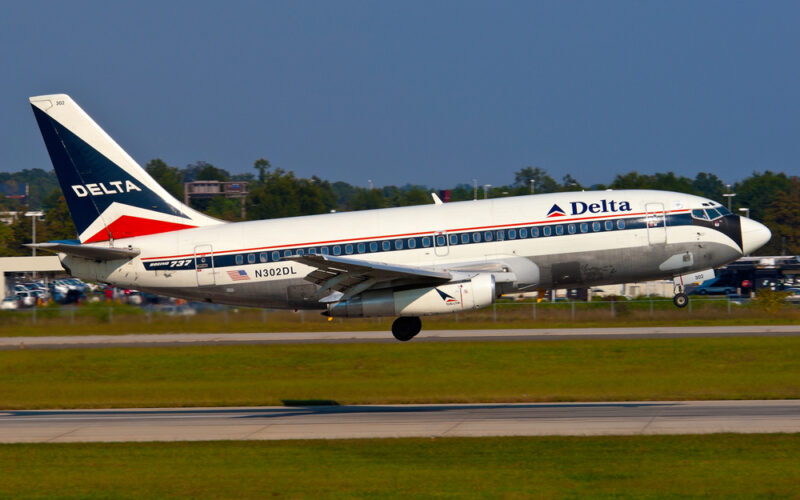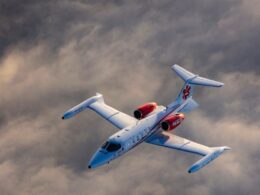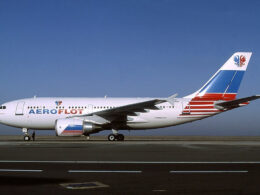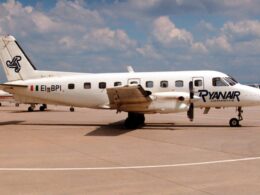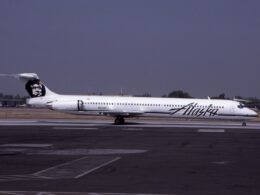The Most Successful Aircraft – The Story Of The Boeing 737
Sometimes the phrase “the most successful” can be a bit vague. However, that is not the case with the Boeing 737.
Boeing’s third commercial jetliner, the Boeing 737 paved the way for the company to be as dominant as they are now. In the 20th century, there we are a lot of big aircraft manufacturers – namely Lockheed, McDonnell Douglas, de Havilland, Sud Aviation and many more.
All of them had two things in common. Firstly, they all built commercial airlines to compete with Boeing. Secondly, they did not succeed in doing so, as all of them are either merged into other companies, bankrupt or do not build commercial aircraft anymore.
One of the reasons why? The Boeing 737, which helped Boeing dominate the commercial aircraft market for 52 years now. Today, it is the most-popular jetliner in the world. Airlines all over the world have ordered over 1500 Boeing 737s, while Boeing themselves made and delivered 10.510 of them so far.
And on this day in history, on April 9th of 1967, the first Boeing 737 took flight.
Ever since making its debut flight, it seemed like the 737 was destined for success. However, nowadays the type is associated with two deadly crashes in Ethiopia and Indonesia that seem to tarnish its reputation as one of the most reliable and successful jets in history.
But how did we get here?
Let’s dig deeper into the story of the 737 and explore the reasons why it even came to be as an airliner.
Saving time and money on the development costs of the Boeing 737
The late 50s were a great time for Boeing. Their first commercial jetliner, the Boeing 707 made a huge impression on the general public and airlines. It became a cultural icon.
Boeing had proved everyone wrong and made a point – commercial aircraft with jet engines are here to stay. The same year that they released the 707, in 1958, Boeing announced they are conducting a design study to complement the Boeing aircraft family.
The new 2-engine jet would stand alongside the 4-engine 707 and the 3-engine 727. As the 737 had only two engines, people nicknamed it the “Baby Boeing”.

United Airlines Boeing 727
Nevertheless, even before the newest Boeing aircraft was released, the Seattle manufacturer faced stiff competition. Boeing knew that there was an increasing demand in the short-haul market and airlines wanted more efficient twin-engine aircraft.
There was the French Sud Caravelle, which began commercial flights in 1959. Douglas had already begun their study of the same short-haul market. The study would conclude in the DC-9, which began commercial flights in 1965. Lastly, the BAC One-Eleven began serving passengers around the world in 1965 as well.
Boeing was behind its competitors. It had to act fast and offer something that no other competitor did, in order to attract customers into buying the 737.
So, in order to catch up quickly, Boeing appointed John Edward “Jack” Steiner to be the chief engineer. Jack had designed the 727, which saw even more success than the 707.
The plan was to use as much of the Boeing 727 as possible for the fuselage and borrow interior parts from both the 707 and the 727 to save time and money.
In 1964, the design was complete.
Never seen before
The main competitors of the Boeing 737 mounted their engines on the back of the aircraft. However, to introduce something that the world has never seen before, Jack Steiner asked Joe Sutter, the father of the Queen of The Skies, to help out with the design.
He came up with a unique solution – to mount the engines on the wings. This resulted in a few pros and cons:
First of all, the new engine mounts significantly improved the cabin. It was quieter, more spacious and had two sets of doors – at the front and at the back. Secondly, it improved performance, efficiency and made maintenance easier.

Boeing 737-200
On the other hand, it made some things difficult. Boeing had to redesign the wings to reduce the impact of the engines on the aircraft’s aerodynamic properties. Ground clearance worried the manufacturer because the engines were mounted much lower. However, these worries did not become fruitful and Boeing did not have to impose radical changes to the mounting points.
So, the engine mounts were the first advantage of the Boeing 737.
But the second advantage was integral to the success of the new jet. It shook the competition and airlines suddenly started to pay a lot of attention to the Boeing 737.
It simply had more space in the cabin, thus was more versatile. The DC-9, Sud Caravelle and the One-Eleven had interiors with 5 seats per row. The Boeing 737 had 6.
Additionally, airlines could easily convert them to cargo aircraft, as the Boeing 737 could be fitted with standard-sized cargo containers. While the older 737s were converted to cargo aircraft, its main competitors ended up in the graveyard.
First Boeing 737 Flight And Orders
As Boeing‘s engineers finished up drawing the designs in 1964, testing began. On 9th of April, 1967 two test pilots took off and touched the sky with the first Boeing 737-100. The two men were Brien Wygle and Lew Wallick. The pilots later recalled that the aircraft “is a delight to fly” and it possesses “beautiful handling”. Later that same year, the FAA approved the jet for flights.
Two years before, in 1965, Lufthansa (LHAB) (LHA) had ordered the first 10 Boeing 737-100 aircraft. This was crucial for Boeing, as without the initial orders the program would’ve been canceled. Later on, United Airlines also ordered the 737-200 making an additional boost. But the last straw to save the 737 was the United States Air Force when it ordered modified Boeing 737s for military use.
In short, the oil prices in the 60s have risen dramatically, which resulted in the 1970s oil crisis – airlines were trying to save as much money as they possibly can and spending money on a new jet was a very welcome idea.
In addition, all aircraft at the time had 3 crew members – 2 pilots and a flight engineer. The Boeing 737 was the first jetliner without a flight engineer and airlines were reluctant to make the change.
The first ever 737 variant, the Boeing 737-100 barely sold – Boeing only delivered 30 units. However, at the same time, United Airlines reached out to Boeing about a longer 737, dubbed the -200. It was longer, seated more passengers and had a newer engine.
The 737-200 was much more popular with airlines. This time, Boeing produced 1114 Boeing 737-200s.
So, after a cold start and when the oil crisis of the 70s ended, the orders for the 737 spiked. Massively.
Many more variants
As the 70s went on and technology moved further, Boeing realized that time has come to upgrade their most popular jet at the time.
So, in the late 70s, the Seattle manufacturer had begun designing and developing the new variant. Nowadays known as the “Classic”, the new Boeing 737 frame was longer, seated many more passengers (30 more, to be exact) and the engines were much more fuel efficient. Boeing promised to airlines that the Classic would burn 20% less than the Original, the 737-100 and the 737-200. The Boeing 737-300 made its first flight on the 24th of February, 1984.

airBaltic Boeing 737-300
The Classic Boeing 737s, the -300, -400 and -500, heavily outsold the Originals. Airlines realized how valuable the 737 is. With ticket prices dropping and more people traveling than ever, the United States government passing the Airline Deregulation Act, low-cost carriers boomed.
But with the aviation industry increasing its profits, Boeing finally had some proper opposition – Airbus came knocking. They released a direct competitor to the 737, the Airbus A320. The European conglomerate forced Boeing‘s hand for the first time in the short-haul market and Boeing was forced to react.
Their reaction? The Next-Generation variants. The 737-600, -700, -800 offered faster cruise speeds, lower burn rate, higher MTOW and a bit more passengers than the Originals.

Ukraine International Airlines Boeing 737-800
Taking the Boeing 737 to the MAX
Airlines absolutely adored the Next Generation 737s. To date, the 737-800 variant is the most popular one with Boeing delivering over 5000 of them to various airlines. Technological advancements and shifting market trends prompted Boeing into a discussion about replacing the 737 with a completely new jet.
But Airbus had a different idea. They wanted to undercut Boeing yet again and came up with the A320neo. Airbus announced an improved version of the same A320 aircraft with reduced fuel rates, lower maintenance costs and more range. If at first Boeing did not think too much, after American Airlines (A1G) (AAL) announced they are purchasing 260 Airbus A320s, current engine option and new engine option included.
Boeing had no other choice – they had to react quickly. American Airlines (A1G) (AAL) announced the orders in 2011 and Boeing came up with the MAX. First up was the Boeing 737 MAX 8, which made its debut flight in 2016. The newer, bigger engines forced Boeing to move them forward. As a result of this, the 737’s nose would pitch up. To counteract this, Boeing installed MCAS – a system to prevent the aircraft stalling in certain situations.
 Boeing 737 MAX Factory
Boeing 737 MAX Factory
And we all know how that ended up. Two crashes and a lot of shocking facts about the training, certification process has followed.
Airbus forced Boeing’s hand, but the 737 is still a 50-year-old airframe.
A 50-year-old airframe that Boeing stretched 3 times into the Classic, NG 737 and the MAX and pushed it to absolute limits. Risking and costing lives in the process, while also tarnishing Boeing’s and the 737 airframe’s reputation. Rightfully so.
What’s next for the 737?
The future might be grim, as the Boeing 737 MAX is sitting on the ground and waiting for aviation authorities to allow the MAX to return to the skies. As of now, Boeing is scrambling to make a software update to prevent MCAS from taking over the controls of the jet.
But on the other hand, the 737 is the most popular commercial jetliner. Whatever the media frenzy might be at the moment, the airframe should not be remembered as deadly and unreliable. The 737 has completely changed the aviation industry and we would be here if it weren’t for it.
So, cheers to you, 737!
But you should seriously think about retirement.





